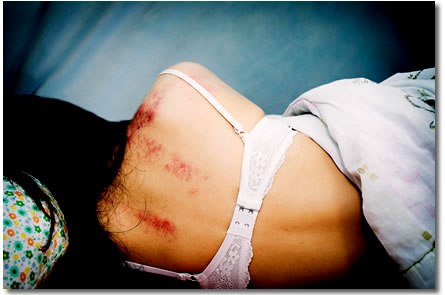 Physical Injuries
Physical InjuriesIt is estimated between 28% to 88% of victims of trafficking, depending on their location and the type of forced labor, are seen in medical facilities during their forced servitude (Baldwin, et al, 2011; Ledere & Wetzel, 2014; Mumma et al, 2017). One victim in one study worked in a long-term care facility. When questioned by a family member who noticed she worked every day, the victim denied there was a problem.
Types of encounters
At small, private medical facilities or doctors’ offices, victims reported being seen for nonurgent care. These visits were prompted by conditions that prevented the victims from working such as respiratory illnesses, injuries or sexually transmittable diseases. Here’s one victim’s description of an injury from which she suffered for 10 days before being seen:
One time, I was cleaning the restroom. I was cleaning the wall, and I was on a chair. I slipped and fell to the floor. It was a hard fall; it’s a cement floor. I couldn’t get up. I was very dizzy ... For 10 days, I had some fluid coming from my left ear ... I couldn’t hear. I had a lot of pain (Baldwin et al, 2011, p. 40).
Emergency department visits were frequent for serious, urgent issues such as broken bones and concussions.
Hispanic traffickers are known to take victims to Las Curanderas, traditional Hispanic healers. Curanderismo is a healing approach based on faith and knowledge of the healing attributes of plants. Some of the victims did not believe in the validity of these approaches for their illnesses. Here was Teresa’s comment in her interview:
They used to take us to people who used to ... do cleansing, like witches, like curanderas (Baldwin, et al, p. 40).
Ledere and Wetzel (2014) studied 106 survivors of sex trafficking, 99% reported a minimum of one physical health issues. The most frequently reported physical problems were neurological (91.5%) which included memory and concentration issues (82%) and headaches (54%).
The subjects also reported the following contacts with various health care providers:
Red flags or signs the patient in the ED may be a victim of traffickers
Where they work
According to the hotline call in center of 4,460 cases, sex trafficking is the most common area of trafficking with 3,186 calls (71%) in the U.S. related to sex trafficking in 2017. Here are the most common venues for sex trafficking.
Types of health issues
The following are common health issues reported in a number of articles (deChesnay, 2013;Lederer & Wetzel, 2014; Becker & Bechtel, 2015; Shandro et al, 2016; Gibbons, & Stoklosa, 2016; Mumma et al, 2017) for which victims of trafficking can be seen in health care facilities, for which they should be screened:
 Physical Injuries
Physical Injuries
- Broken bones
- Bruises
- Burns – cigarettes, iron, acid
- Gunshot wounds
- Hair pulled out
- Scars
- Broken teeth
- Vaginal and anal tearing
- Urinary difficulties
- Urinary tract infections
- malnutrition
- Concussions, head trauma
- Memory loss
- Dizziness
- Headache
- Numbness
- Untreated chronic health conditions
- Malnutrition
- Asthma
- Diabetes
- Dental problems
- Diseases from unsanitary housing and dirty needles
- Tuberculosis
- Hepatitis
- Malaria
- Pneumonia
- Substance abuse
- Sexually transmitted infections
- Chlamydia
- Gonorrhea
- Syphilis
- HIV/AIDS
- PID
- Pubic lice
- OB/GYN issues
- Unwanted pregnancy
- Miscarriage
- Frequent abortions
- Menstrual problems
Psychosocial distress
- Depression
- Anxiety
- Panic attacks
- Shame and guilt
- Emotional and physical abuse including PTSD
- Social marginalization
- Legal insecurity
- Economic exploitation
- Helplessness
- Memory loss
- Forced substance use
(Shandro et al, 2016; deChesnay, 2013;
What to look for
Healthcare providers are some of the few groups that have frequent contact with victims of trafficking. They are in a unique position to provide support and assistance.
What to look for initially
Indicators of Human Trafficking
Baldwin, S.B., Eisenman, D.P., Sayles, J.N., Ryan, G. & Chuang, K.S. (2011). Identification of human trafficking victims in health care settings. Health Hum Rights. 13(1), e36-e49.
Becker, H.J. & Bechtel, K. (2015). Recognizing victims of human trafficking in the pediatric emergency department. Pediatr Emerg Care.31(2),144-7.
Crane, P.A. & Moreno, Melissa (2011). Human Trafficking: What is the Role of the Health Care Provider? Journal of Applied Research on Children. 2(I), 1-28. Available at: http://digitalcommons.library.tmc.edu/childrenatrisk/vol2/iss1/7
deChesnay M, et al. (2013). First-person accounts of illnesses and injuries sustained while trafficked. In: deChesnay M, ed. Sex Trafficking: A Clinical Guide for Nurses. New York, NY: Springer Publishing LLC; 131–150.
Gibbons, P. & Stoklosa, H. (2016). Identification and Treatment of Human Trafficking Victims in the Emergency Department: A Case Report. J Emerg Med. 50(5), 715-9.
Lederer, L.J, & Wetzel, C.A. (2014). The health consequences of sex trafficking and their implications for identifying victims in healthcare facilities. Ann Health Law. 23(1), 61-91.
Mumma, B.E., Scofield, M.E., Mendoza, L.P., Toofan, Y., Youngyunpipatkul, J. et al. (2017). Screening for Victims of Sex Trafficking in the Emergency Department: A Pilot Program. West J Emerg Med. 18(4), 616-620.
Shandro, J., Chisolm-Straker, M., Duber, H.C., Findlay, S.L., Munoz, J., Schmitz, G., et al. (2016). Human Trafficking: A Guide to Identification and Approach for the Emergency Physician. Ann Emerg Med. 68(4), 501-508.
©RnCeus.com